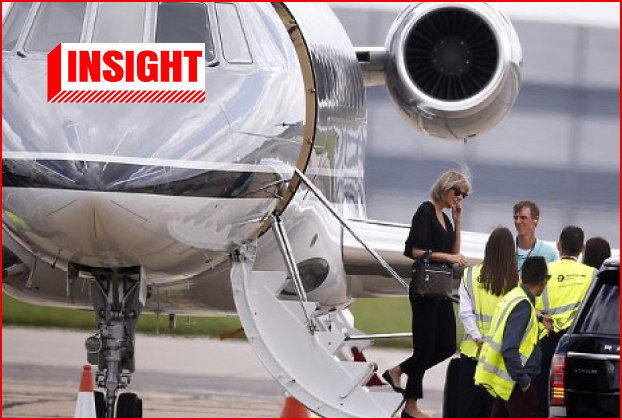
Pop star Taylor Swift is presently engaged in a legal dispute with Jack Sweeney, a university student from the University of Central Florida. The contention arises from Sweeney’s activity of monitoring and publicizing information about the private jet usage of several celebrities, one of whom is Taylor Swift.
Who Is Jack Sweeney?
Jack Sweeney, a 21-year-old junior at the University of Central Florida, operates social media accounts that diligently track the takeoffs and landings of celebrities’ planes and helicopters, including Taylor Swift’s. This interest in flight paths and carbon footprints led him to create TheAirTraffic, a website enabling users to follow specific flights in real-time.

Sweeney rose to prominence in 2022 when he started tracking Elon Musk’s private jet and posting its locations online. Utilizing publicly accessible Federal Aviation Administration (FAA) data and aircraft broadcast signals, Sweeney’s work earned him accolades, including a place on Forbes’ 30 Under 30 list. His efforts have been praised for highlighting the environmental impact of private jet travel.
In May 2023, TCPalm reported that Sweeney had set up jet tracker accounts for other celebrities, as outlined in this article.
- Elon Musk: Musk offered Sweeney $5,000 to shut down the @elonjet account. Sweeney declined and created a new account, @ElonJetNextDay, after Musk had the original suspended.
- Gov. Ron DeSantis: Despite DeSantis’s bill to hide flight records, Sweeney tracks the governor’s plane with the @DeSantisJet account.
- Mark Cuban: Sweeney agreed to take down @CubanJet from Twitter in return for lifelong business advice from Cuban.
- Mark Zuckerberg: @ZuccJet monitored Zuckerberg’s private jet until Twitter suspended the account.
- Other celebrities with jet tracker accounts include Robert Pera, Donald Trump, Mark Wahlberg, Blake Shelton, Kylie Jenner, Kim Kardashian, Drake, Steven Spielberg, and Tim Cook.
The Legal Dispute
In December, Swift’s attorneys from the Washington-based law firm Venable alleged that Sweeney’s actions could be interpreted as ‘stalking and harassing behavior’ related to his tracking of Swift’s jet activity. They sent him a cease-and-desist letter, emphasizing that this matter was a “life-or-death” concern for their client. Swift has dealt with stalkers in the past, and her team expressed concern about providing potential threats with information about her whereabouts.

Sweeney maintains that his intention was not harmful; he aimed to raise awareness about celebrities’ private jet usage. His tracking accounts rely on publicly available data and do not provide a complete real-time picture of Swift’s location.
Taylor Swift’s Private Jet Usage
- In 2022, Swift was ranked as the No. 1 celebrity carbon-dioxide polluter by sustainability marketing firm Yard. It was estimated that her emissions were 1,184 times that of the average person.
- Swift’s spokesperson stated that her private jet was regularly loaned out and she purchased more carbon credits than necessary to offset her tour travel. Despite this, factors such as Swift’s specific security requirements, which can make commercial flights impractical, and her practice of loaning her jet to others should be considered. Swift has also undertaken measures to offset her carbon emissions.
- Swift has recently sold one of her two personal planes as part of her efforts to lessen her carbon footprint. As a result, in 2023, her ranking reportedly dropped significantly, placing her outside the top 30.
embed: https://twitter.com/PopFactions/status/1755194440778490060
Private Jets and Climate Change
How Do Aircrafts Contribute Climate Change?: Aircrafts contribute to climate change primarily through emissions of greenhouse gases like carbon dioxide, nitrogen oxides and water vapor. Carbon dioxide is a direct byproduct of burning jet fuel, while nitrogen oxides are produced by engines during combustion. During engine combustion, airplane engines can heat up to 2000°C, resulting in high pressure. At these conditions, oxygen and nitrogen in the air join together to form nitrogen oxides.
Additionally, aircrafts emit water vapor, which can form contrails and cirrus clouds, both to which contribute to atmospheric warming. In 2019, overall carbon dioxide emission was estimated as 37.08 billion tons. From this, 1.04 billion tons were contributed by aviation. That means aviation accounted as 2.8% of overall global carbon dioxide emission. When considering full greenhouse gas emission, aviation is responsible for at least 3.5% of global warming.
A typical private jet burns around 5000 gallons of fuel per hour. An average commercial jet only burns about half of that fuel quantity. Also, fuel burn of private jet is equal to about 400 of passenger cars fuel usage per hour. In 2019, private jets have been released 899 000 metric tons of carbon dioxide to the atmosphere. This is 0.9% from the global aviation emissions.
However, the researches have been indicated that private jets produce 5 – 14 times more pollution per passenger than commercial planes.
How Do Private Jets Cause Higher Emissions Per Passenger than Commercial Airlines?
Private jets typically contribute higher emissions per passenger mile compared to commercial airlines for several reasons.
- Lower occupancy: Private jets often fly with fewer passengers compared to commercial flights, where planes are usually filled to capacity. This means that the emissions generated per passenger are spread over fewer people, resulting in higher emissions per passenger mile.
- Less efficient aircraft: Many private jets are older models that are less fuel-efficient than newer commercial aircraft. They may lack the advanced technology and design features that improve fuel efficiency and reduce emissions.
- Shorter flight: Private jets are often used for short flights, which tend to have higher emission per mile due to the fuel consumed during takeoff and landing phases. Commercial airlines can achieve economies of scale by operating longer flights, which spread the emissions over more miles.
- Lack of regulations: Private jets are subject to less stringent emissions regulations compared to commercial airlines. Commercial airlines are required to adhere to strict emissions standards and are incentivized to invest in more efficient aircraft and operational practices to reduce their environmental impact.
Despite the convenience and flexibility that private jets offer, their contribution to carbon emissions is a serious concern. They significantly contribute more carbon emissions per passenger mile compared to commercial airlines, highlighting the environmental cost of such luxury.
Sources:
Follow us and stay up to date with our latest fact checks.
Facebook | Twitter | Instagram | LINE | TikTok

Title:The Impact of Celebrity Jet Usage: A Case Study of Taylor Swift
Written By: Fact Crescendo TeamResult: Insight






